No matter where you usually hear today’s top hits—the radio, Spotify, a mixtape on your Sony Walkman—you’ve probably noticed that they tend to be around three minutes long.
As Vox explains, the custom dates back to the early 20th century, when shellac records first appeared in the market. The rates at which these records spun varied, but 78 revolutions per minute (RPM) quickly became the norm. The most popular record sizes were 10 inches—which could hold about three minutes of music per side—and 12 inches, which held roughly four to five minutes per side. To get radio stations to broadcast their music and get people to buy it, musicians pretty much had to accommodate those time limits.
The late 1940s saw the birth of the 45 RPM record: a smaller, cheaper disc made of vinyl that couldn’t manage much more than three minutes of music per side. Long-playing records (LPs) were introduced around the same time, but it was much easier for radio stations to play single tracks from 45s—which hordes of listeners then went out and bought. While 10-inch 78s had originated the three-minute trend, 45s really helped make it a necessity for radio singles throughout the mid-20th century.
There were definitely exceptions to the rule. Bob Dylan’s 1965 song “Like a Rolling Stone” runs more than six minutes, and fans overwhelmed radio stations with calls demanding the full version. It worked: “Like a Rolling Stone” became an unlikely radio hit. More often, musicians would just cut a shorter radio edit to release as a single for radio play—like David Bowie’s 1977 classic “Heroes.” If you wanted to hear the full six minutes and change, you could buy the LP.
As music technology evolved over the years, from records to cassette tapes to CDs, three minutes didn’t fall out of fashion as the de facto estimate for pop songs. According to Classic FM, this is partly because radio stations could fit more commercials into a program if the songs stayed relatively short. Record labels may have favored shorter singles, too, since longer songs didn’t mean fatter royalty checks. It’s also likely that pop music listeners just preferred concision; after all, it’s what the last several decades had taught them to expect. As Thomas Tierney, director of the Sony Music Archives Library, told Mashable, “it’s embedded in our DNA.”
The current digital music landscape seems more conducive to longer pop songs than anything that came before it. For one, there aren’t so many physical restrictions to account for, like the size of a record. And with millions of people streaming pop songs these days—or hearing them on TikTok—radio is no longer the only vehicle for catapulting musicians to mainstream success. But if you scroll through a Top 40 playlist today, you won’t see a bunch of six-minute songs. In fact, many tracks come in under three minutes long. Justin Bieber’s “Ghost” is just two minutes and 33 seconds, and Lil Nas X’s “THATS WHAT I WANT” is a tidy two minutes and 23 seconds.
Shorter attention spans and social media’s influence might explain the trend toward brevity, but it’s not the only factor: The compensation model matters, too.
“Instead of getting paid by physical sales, you’re getting paid in a stream, which only counts if someone listens to 30 seconds of a song,” songwriter Charlie Harding told The Verge. “It actually makes sense if you can have more songs streamed at a time, which means that you want to pack your album full of much shorter songs.”
In other words, success is now less about sales and more about number of streams. Today’s pop stars are making music that reflects the shift—not unlike how 20th-century musicians learned to work within the confines of the original three-ish-minute limit.
